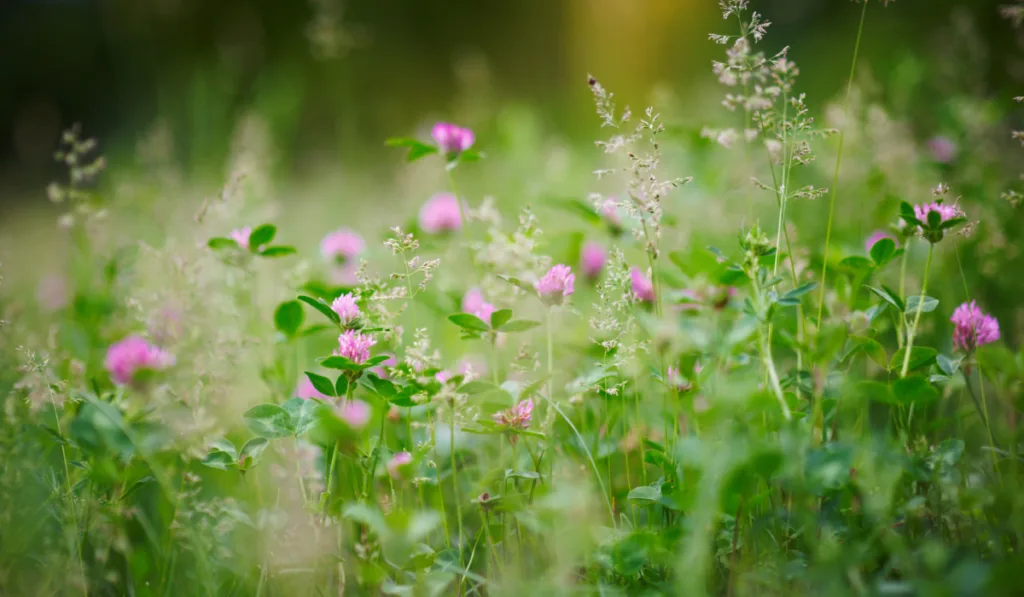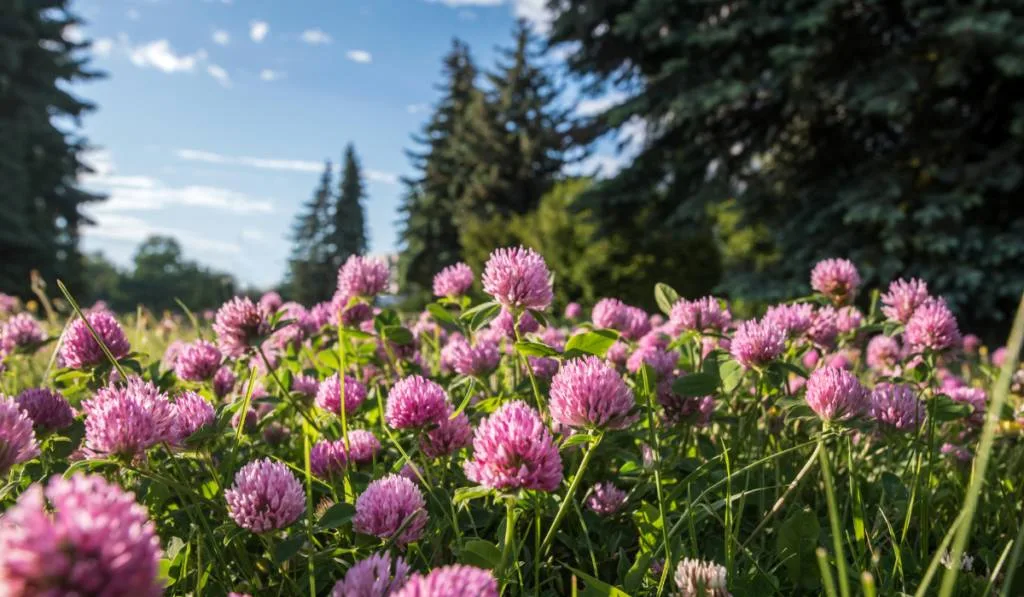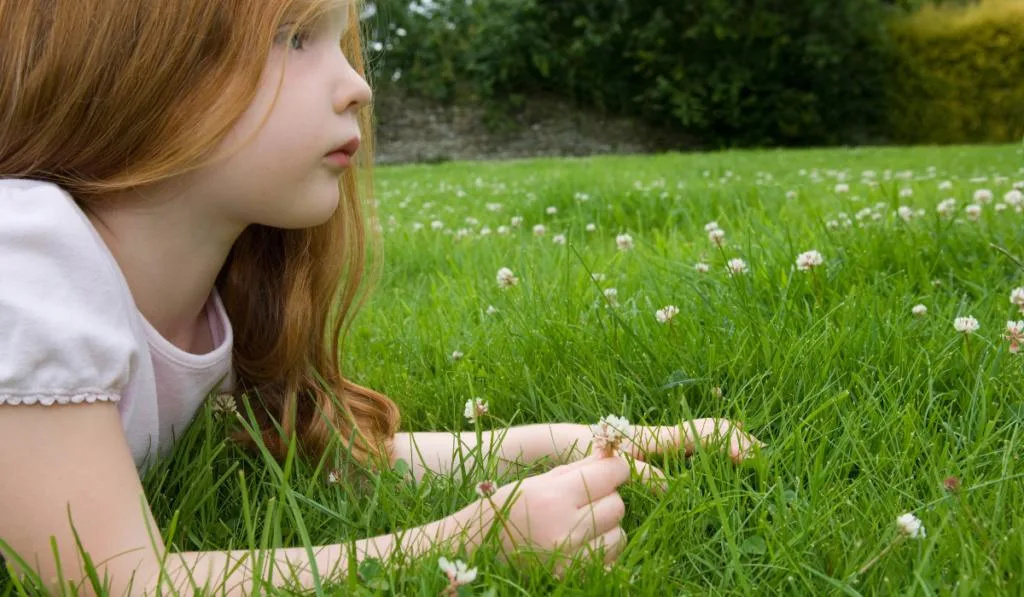Many people love red clover (Trifolium pratense) for its large crimson blossoms, and herbivorous animals adore it for its taste and nutritional value. When you plant red clover in late summer, it will thrive the following spring, making your kitchen garden a sight to behold and the first place pollinators go.
But it is not all about beauty. Beyond its aesthetic appeal lie many interesting facts about this legume.
Gardeners have grown red clovers for centuries. Some consider it medicinal while others consume it for its nutritional value.
Furthermore, red clover is an excellent cover crop. It improves soil health through green manure, preventing soil erosion, and fixing nitrogen back into the soil.
Explore seven facts about red clovers, their historical significance, and applications from this post.

Table of Contents
Can I Mow Red Clover?
You can mow red clover, and the practice benefits the plant’s growth.
Mowing red clover stimulates regrowth at the crown. More foliage growth leads to increased photosynthesis and healthier plants.
You should expect more nitrogen for your garden soil after mowing. It does not affect the plant’s nitrogen production.
The best time to mow your red clovers is before weeds produce viable seeds. This prevents the weeds from germinating again.
Flail mowing works best because it doesn’t leave large clover piles that can suppress new growth.
You can use the forage to feed livestock or make green manure as you prepare for the next planting season.

How Tall Does Red Clover Grow?
Red clover grows up to 2-3 feet tall. However, the height can exceed this or be less, depending on prevailing conditions.
Like most legumes, red clover does well in weakly acidic loam soils. Although it tolerates soils with a pH lower than 5, it cannot attain the maximum height in such soil conditions.
Moderate to heavy-textured soils are good for this crop, but they should be well drained.
The maximum height your red clover attains also depends on prevailing weather.
Under dry conditions, the plant survives but may not attain its best height if the drought persists. Other ideal growth conditions include:
- Exposure to sunlight
- Pest and disease-free soil
- Medium to high temperature
Will Red Clover Reseed?
Red clover reseeds like other perennial crops, but not always. Red clover will reseed under favorable conditions, such as warm soil and enough moisture.
This makes the red clovers thrive into a big bush during warm seasons like spring and summer.
Reseeding in red clover is an adaptation where seeds germinate into a new plants within a year of forming. This, however, is subject to prevailing weather.
During winter, red clover seeds hardly germinate due to the low temperatures. Therefore, you should pick the seeds and plant them after winter if you want to grow the crop in the future.

If your geographical area experiences harsh winters, you have to plant the crop after the cold season. On the other hand, you can help the plant reseed if your area experiences warmer winters.
How do you help red clover reseed?
The trick is simple. Ensure you subject mature fields or plants to favorable conditions, which include:
- Enough water. Keep your soil moist and well-drained.
- Favorable temperature. Mature red clover requires at least four hours’ exposure to sunlight daily. This keeps the soil warm and the plant nourished.
- Keep the soil pH between 6.0 to 6.5. Red clovers do well in weakly acidic soils.
- Keep the garden free of pests. Like other plants, red clovers are prone to pest attacks. Therefore, keep your garden pest-free using pesticides and natural control.
Note that reseeding continuously may lead to your crop growing out of proportion. You should manage its growth to preserve its aesthetics and other qualities.
You can manage reseeding by:
- Pruning. When the crop season ends, you can prune it to prevent reseeding.
- Creating a barrier to enclose the crops’ growing area. Doing this helps to remove plants that germinate outside the barrier and contain their population.

Is Red Clover a Good Cover Crop?
Red clover is a good cover crop you can easily grow.
If you are looking to grow a cover crop that adapts well to different soil types, you may need to consider red clover.
Being a very good cover crop, you can grow red clover as an annual, biannual, winter annual, or short-lived perennial crop.
It reseeds under favorable conditions, and therefore you can grow the crop for varying time lengths.
If you wonder what makes red clover a good cover crop, explore some of its benefits below.
- Grows well in different soil types, including medium and high-fertility soils.
- They attract beneficial insects. Red clovers have large, brightly colored blossoms which attract insects. This makes pollination and pest control more efficient in your yard.
- High biomass production makes it great for green manure. When you kill red clovers at the end of the season, its high biomass produces excellent green manure. It prevents soil erosion as well.
- Produces large quantities of dry matter. An acre of red clovers produces about 2-3 tons of dry matter. You can use it as mulch or animal feed.
- Weed control. Red clover is a great weed suppressor. Its high biomass smothers the weeds, making your soil more productive.
- Livestock feed. Red clover offers a good grazing medium for your cattle. You should graze your animals 4-6 weeks before winter. This helps to prepare medium-cut clover for winter.
In addition to the above benefits, red clover has long taproots which hold soil particles together. This prevents soil erosion.
It also supplies the soil with nitrogen through fixation.

Can I Use Red Clover Instead of a Lawn?
You can use red clover in your lawn, but you should blend it with other grass and clover varieties.
The red or pink blossoms are too bright for your lawn. That is why you should blend it with green grass, white clover, and other grass varieties. The leaf and plant size also make it not ideal for lawns, even when mown regularly.
The benefits of a red clover lawn over grass lawns include:
- Minimal watering. Red clovers require low water content, hence less watering.
- You don’t need to apply fertilizer to your lawn. Red clovers improve soil fertility through green manure and erosion control. They also increase the soil nitrogen levels.
- Little mowing. Red clovers suppress weed growth. If you mix this crop with other grass varieties in your lawn, your grass will take longer to sprout, hence requiring little mowing.
You can mow your red clover lawn after 35-40 days. This makes a red clover lawn economical to maintain.
To avoid damaging the crop, ensure you use the highest mower setting.
Red clover is an eco-friendlier crop for your lawn. It requires no use of chemical fertilizers and is risk-free for your pets.
Additionally, animal urine (such as dog urine) hardly discolors it.

Best Gardening Conditions to Grow Red Clover
Red clover is a drought-resistant and winter-hardy crop. And you can grow it in different soil types. Most zones within the US can grow red clover provided its requirements are met.
The best gardening conditions for growing red clovers should:
- Experience full sunlight or partial shade with at least 4 hours of exposure to sunlight daily.
- Rich in loam or clay soil.
- Have moist but well-drained soil.
- Have 6.0-6.5 soil pH.
- Free of pests such as clover root borer and seed midge. This crop is also prone to diseases such as powdery mildew.
Benefits of Red Clover to the Body
Some healthcare practitioners believe that red clover has medicinal effects on the body.
The benefits of this crop to your body include:
- Detoxification. Red clovers help the body to get rid of excess fluid, hence purifying the blood.
- Expectorant. Red clovers clear the lungs of mucous. This improves circulation and cleanses the liver.
- Isoflavones from red clovers have estrogen-like effects on the body. These components treat menopause-associated conditions such as cardiovascular problems and hot flashes.
Researchers are also studying the role of isoflavones in cancer treatment and prevention since they can trap cancer cells and prevent their growth.
- Other uses include making ointments and cough remedies.
Remember to consult a medical expert before using red clover and its extracts for treatment.
Final Thoughts
Red clover is among the most beneficial crops for beginners and veterans in gardening.
From the eye-catching blossoms that add to your yard’s aesthetics, to medicinal and ecological benefits, red clover remains relevant to the modern gardener.
You can grow it for beauty, nutritional benefits, and soil health in the coming season.
Moreover, the crop does well in different soils and climatic conditions, either as a cover crop or a main crop.
Resources
- https://www.canr.msu.edu/news/managing_red_clover_that_was_frost-seeded_into_wheat
- https://extension.missouri.edu/publications/g4638
- https://www.epicgardening.com/red-clover-plant/
- https://redemptionpermaculture.com/will-red-clover-reseed-itself-heres-the-answer/
- https://www.canr.msu.edu/news/benefits_of_using_red_clover_as_a_cover_crop
- https://lawnlove.com/blog/what-is-red-clover/
- https://www.mountsinai.org/health-library/herb/red-clover
- https://www.mountsinai.org/health-library/herb/red-clover
